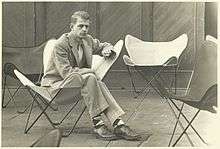Roy Harrover
| Roy Harrover | |
|---|---|
 1953 | |
| Born |
November 23, 1928 Dayton, Ohio |
| Nationality | American |
| Alma mater |
Yale School of Architecture (B.Arch, 1953) |
| Occupation | Architect |
| Awards |
Progressive Architecture Award National Design Merit, AIA Time Magazine, Best of 1983 U.S. Navy National Design Award |
| Practice |
Mann & Harrover Roy P. Harrover & Associates |
Roy Perkins Harrover, FAIA, is an award-winning American architect who designed the Memphis International Airport and numerous civic buildings across the South. His designs range in style from New Formalist to Brutalist and are characterized by their strictly linear forms. He is largely credited with establishing a modern architectural identity for Memphis, Tennessee.[1]
Early life
Born in Dayton, Ohio on November 23, 1928,[2] he moved with his mother to Nashville following his parents' divorce. At age 14, Harrover was hired by Vultee Aircraft to construct accurate models of their airplanes.[3] He later served in the U.S. Marine Corps from 1946 to 1948, then attended Yale University on the G.I. Bill, studying under Vincent Scully, King-lui Wu, Louis Kahn and visiting critics Buckminster Fuller and Philip Johnson. In 1953, Harrover graduated first in his class.
Architecture
Following graduation, Harrover worked briefly as chief designer under Paul Schweikher. In 1955, he moved to Memphis and established the architectural firm Mann & Harrover with partner William Mann. They won a design competition in 1959, judged by Philip Johnson and Paul Rudolph, for the new Memphis Art Academy (now known as the Memphis College of Art).
Mann died of lung cancer a year before Harrover finished designing the Memphis International Airport. It was unveiled in 1963 and was among the first airports to make use of jetways and a two-level system. It is particularly noted for its distinctive martini glass columns. Once all projects involving Mann were completed, Harrover renamed the firm Roy P. Harrover & Associates.[1]
In the late 1970s, Mayor J. Wyeth Chandler commissioned Harrover to repurpose a defunct sandbar in the Mississippi River as a means of revitalizing downtown Memphis. Dredges were deployed to raise the sandbar above flood level, upon which Harrover designed the Mud Island River Park: an entertainment complex featuring a scale model and museum of the Mississippi River, an amphitheater, as well as shops and restaurants, all strung along a promenade made accessible from downtown by monorail.[4]
Harrover was awarded honorary Doctorates in Fine Arts by Rhodes College and the Memphis College of Art.[1] He closed his firm in 1994 and began full-time consulting work. He is now retired.
Notable Works
- Memphis International Airport (1963)
- Mud Island (1982)[4]
- Memphis College of Art (1959)
- One Commerce Square (1973)[5]
- Church of the River (First Unitarian Church of Memphis). (1965)[1][6]
- U.S. Embassy in Lagos, Nigeria[1]
Footnotes and References
- 1 2 3 4 5 Finger, MICHAEL. "Modern Man". Memphis magazine. Retrieved June 22, 2015.
- ↑ "Roy Perkins Harrover". Retrieved June 22, 2015.
- ↑ "Boys' Life, Mar. 1943". Retrieved July 9, 2015.
- 1 2 "Mud Island River Walk". Memphis Downtowner. Retrieved July 9, 2015.
- ↑ "Emporis". Retrieved July 9, 2015.
- ↑ Roper, James (November 9, 2010). "The Church of the River lived up to its name with cutting-edge design". Retrieved June 22, 2015.